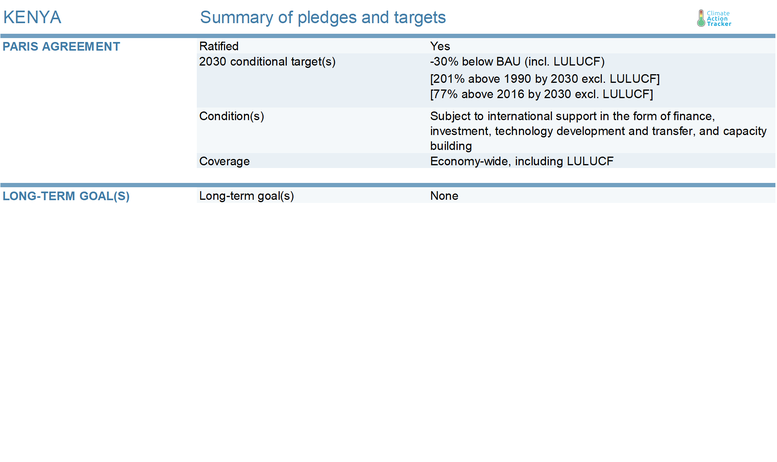Pledges And Targets
Summary table

Paris Agreement targets
NDC update: In December 2020, Kenya submitted a new NDC. Our analysis of its proposed target is here.
Kenya ratified the Paris Agreement on 28 December 2016 (MENR, 2017b). Kenya seeks to abate its greenhouse gas (GHG) emissions by 30% by 2030 relative to the business as usual (BAU) scenario of 153 MtCO2e (143 MtCO2e using IPCC SAR values) including LULUCF and 131 MtCO2e, if LULUCF is excluded. A 30% reduction relative to the BAU scenario equates to 110 MtCO2e in 2030, excluding LULUCF. The target is conditional on international support (MENR, 2015).
The abatement contribution of various sectors to the 30% reduction varies (MENR, 2017b). The LULUCF sector contributes the largest share (47%) to the overall emissions reductions target, with all the remaining sectors together contributing 53%. The electricity supply subsector contributes the second-largest share (22%), followed by the energy demand (14%) and the transport subsector (8%). Agriculture (6%), industrial processes (2%) and waste (1%) contribute the rest.
After excluding LULUCF and considering its disproportionately high share of the total emissions reductions target, Kenya’s maximum GHG emissions limit (excl. LULUCF) in 2030 is 110 MtCO2e. See the Assumptions for further details.
Considering the fact that the bottom-up sectoral analysis, prepared as part of developing its NDC identified the potential to reduce projected emissions by 2030 by 60% (MENR, 2017b), i.e. twice as high as the current conditional target, there is potential for Kenya to strengthen its conditional target as well as adopt an unconditional one.
The Kenyan Government plans to publish its updated NDC in the coming months and has initiated the process of developing the country’s "2050 Long-Term Greenhouse Gas Strategy and Carbon Resilience Development Pathway under the Paris Agreement" (WRI, 2019).
Further analysis
Latest publications
Stay informed
Subscribe to our newsletter






